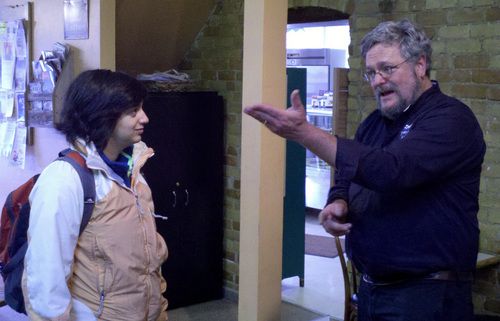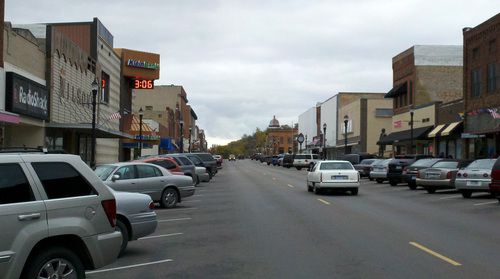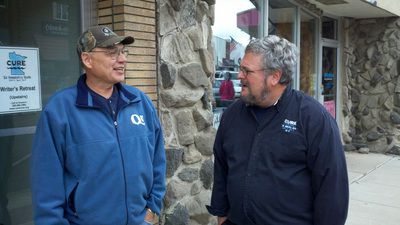Mona Majid, left, a Twin Cities resident, doesn’t know it yet, but she’s likely a future resident of the Upper Minnesota River Watershed region. Patrick Moore, right, has that effect on people. Ms. Majid was visiting an artist friend last week and Moore, nominated by Lynn Mader for News Cut’s “You Should Meet” series, countered every reason she gave for not moving to Montevideo with a reason why she should, giving up only after failing to sway her with, “we’ve got the world’s oldest rock here.”
Still, it’s likely Ms. Majid drove back to the Cities thinking what, one imagines, everyone who encounters Mr. Moore thinks: Montevideo isn’t like most other places.
“We’ve been losing population since World War II,” he told me last week in introducing me to the Upper Minnesota River Watershed region. “There’s been a mass exodus of young people from the region, and we’re one of the oldest populations in the country. People come here and study us because this is what the rest of the country is going to look like in 20 years.”
Some people in the Twin Cities are studying what’s happening in Montevideo for another reason: it doesn’t appear to be dying, even after Walmart opened its store years ago and, like many other small towns, “dropped a bomb” on the downtown.
But many small towns don’t have a Patrick Moore. He had a love of historical buildings and a desire to organize. So he borrowed $6,000 from his brother and put it down on a contract for deed on a $30,000 building. And he opened Java River, a coffee shop and restaurant that helped return a downtown to downtown.
“The coffee shop was my graduate school,” he says. “I learned so much from people I had never met before and all of my stereotypes were challenged on every level — from what it means to be a small business person and what it takes to run a business, the value of education.”
A community organizer by training, a western Minnesotan by adoption, Moore helped create what every successful community needs: a sense of community.
“As a result of me just trying to schmooze people and get them to come back,” he said, “I met all sorts of new people. I lived in town for eight years, I had this nice back-to-the-lander group of friends… in a sense I feel like it’s who I am, but it’s really limiting if that’s all you’re talking to.”
“We started the coffee shop and I said to my staff , ‘we’ve got 15 seconds to acknowledge someone walking in the door.’ Part of it is when you’re making their drink, you’d say ‘who are you, where you from, how you doing today?'”
Lots of businesses have people who say those things; few have people who actually want to know. Once armed with the identity of the customer, the staff would introduce them to others.
Java River became “a place where these different groups meet — the born-again Christians, the tree huggers, the Republicans, the Democrats, the young, and the old,” Moore says.
Come for the coffee, stay for the community. Enjoy a political debate, and like each other even more when it’s finished.
“When we fixed up the Hollywood theater and all the Democrats and Republicans got together to save the building, we didn’t agree one iota on the Iraq war or the presidential election and we would get in big arguments about that. But we agreed that that building shouldn’t be torn down. You can’t predict what people are going to agree on, and you can’t predict what the ‘aha’ moment is for people, but there always is one if you stay in a relationship long enough, and keep that tension long enough, and focus on fun. It’s about laughing together.”
“It’s empowerment. It’s creative empowerment. And I think it’s going on everywhere and we’re one expression of it,” he says. “People would come in and say, ‘ I’ve always wanted to have an art show,’ or ‘do you think I can sing?’ And I’d say ‘yes.’ It gives people permission to be themselves.
After “graduating” from Java River, Moore joined CURE — Clean Up The River Environment — which focuses on the Minnesota River. He used many of the same organizing techniques from the coffee shop at CURE, which now has a storefront office on the city’s main street.
It’s no coincidence, perhaps, that many of the businesses in the area have the word “river” in their name. Moore and the people of the communities have created an “identity” for the region around the river that runs through it.
“Let’s suspend judgment and let’s find areas where we agree,” he says, about approaching a solution to its pollution. “We might not agree on (agricultural land) drainage, but we might agree on buffer strips. Whatever. That takes time. It takes relationship building and dialogue. We say we build the road by walking.”
“I live in hope that as we are bringing farmers from the Minnesota River down to Lake Pepin and Lake Pepin up (to Montevideo), and as we sit around here with the 7,500 cow dairy operation, that we are going to find something.”
As we walked along Montevideo’s main street on the way to lunch at Java River, Terry Overlander of KLQP radio stopped to solicit donations for a Dawson Chamber of Commerce fundraiser. “I appreciate it, even though I don’t agree with all of your positions,” he said after getting one.
“It doesn’t matter,” Moore said. “It only matters that we’re all residents of the Upper Minnesota River watershed.”
Moore says he was “a river rat” as a kid, growing up at Fort Snelling, playing in the Minnesota River when, he acknowledges, it was at its most polluted state. “And it hasn’t affected me….affected me… affected me a bit,” he laughs.
But he acknowledges the serious problem facing the river.
“We’re in the middle of an intractable debate between farmers and downstream people who are affected by the incredible amount of drainage going on,” he says. “As the crop prices increase, it’s driving more of it. You can’t even buy tile anymore. if you don’t have an order, forget it, it’s already spoken for. They’re going to plow up more land, and be draining it.”
The board of CURE features both the tree-huggers and the the farmers, a fact alone that suggests a different way of solving problems in the region.
“You create momentum because people are empowered, they’re having fun, and they come around. They aren’t evil,” he says. “That’s the old model I was taught: organize people around anger. And I know how to do that. We’ve stopped coal plants and river-straightening projects that way. But that is not any fun. I’m over that. I have seen so many transformative things happen that didn’t involve struggle; it involved a fun, collaborative, community ‘aha.'”
“It’s about developing relationships to the point where they become transformational and you have to be open to being transformed, and to transforming people. There are solutions we’ve never thought of and can’t imagine. The issues of energy and food are only going to lead to discord, and war and famine. Israel was once the land of milk and honey. What happened? Misuse of resources happened. Erosion happened. I don’t want Minnesota to become the next middle east. I love this state, I believe strongly in this culture, we’re a practical people. We like to work with our hands. We like to get stuff done. We know how to work together when we need to. So there’s a practicality to the culture that I get here that I don’t get anywhere else.”
He attributes the region’s battle-back nature to the culture. “This was the hotbed of resistance to the foreclosure movement,” he points out, showing a price that accompanies every story about the Upper Minnesota River region. “This is where people said, ‘No, you’re not going to do this. You’re not going to borrow us money when land and crop prices are high and then when they drop, take the land from these hardworking people.'”
“It was a combination of the Scandinavians and the Norwegians… they came over here to get away from the king. And they weren’t going to replace the king of Norway with the king of the railroad.”
Moore says he didn’t really get to know western Minnesota until he graduated from the University of Minnesota Morris and moved to Milan to be the newspaper editor. “There was this town-and-gown thing where there wasn’t a lot of integration. I didn’t hang with people who weren’t college educated until I moved … I was the only Irish Catholic in a town of Lutherans.”
He became, he says, the “one-person chamber of commerce,” connecting artist and “people who really loved history and really loved the land, and they loved to fish and they loved to hunt and they were creative.”
He left Milan for a job in the Twin Cities and took a job with the Land Stewardship Project, but after after five years, he convinced his wife to move back here. “I long to have that big prairie sky and that feeling of openness. It literally feels good to me when I get on Highway 7 and we get past Hutchinson. There’s a sense of ‘you can see the whole.'”
“We have a lot of stuff going on and it’s very exciting. We’re animators. We’re like yeast or bumblebees. We can see the whole and connect and make people feel welcomed.”
“The river metaphor is there’s a stream; you align with it and you let it carry you and you take steps where you can to get out of the way of danger. My motivation is nothing short of love for people and excitement that comes with creative collaboration.”
Do you know of someone we all should meet? Who’s the most interesting person you know? Submit their name and tell me why.



